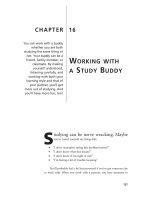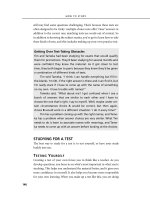Working with a Study Buddy
Bạn đang xem bản rút gọn của tài liệu. Xem và tải ngay bản đầy đủ của tài liệu tại đây (83.32 KB, 10 trang )
127
CHAPTER
16
W
ORKING WITH
A
S
TUDY
B
UDDY
You can work with a buddy
whether you are both
studying the same thing or
not. Your buddy can be a
friend, family member, or
classmate. By making
yourself understood,
listening carefully, and
working with both your
learning style and that of
your partner, you’ll get
more out of studying. And
you’ll have more fun, too!
S
tudying can be nerve wracking. Maybe
you’ve heard yourself say things like:
• “I don’t remember seeing this problem before!”
• “I don’t know what this means!”
• “I don’t know if I’m right or not!”
• “I’m having a lot of trouble focusing.”
You’ll probably feel a lot less pressured if you’ve got someone else
to work with. When you work with a partner, you have someone to
Two Heads Are Better Than One
Jack: “What a waste of time. I don’t know why the sociology
instructor showed us that movie. Nothing much happened in it.”
Jill: “I disagree. I was really impressed by the way the people of the
village stuck together and the way they treated their children.”
Jack: “That’s true. I was surprised. You’d think those kids would
be spoiled by all that affection, but it was just the opposite. They
really cared about each other. I guess that’s why the instructor
showed it. But it was still too long.”
Jill: “I didn’t understand the part about the government workers
coming to the village. Why couldn’t they just leave the villagers
alone?”
Jack: “I kind of liked that part; there was more action, with the
trucks coming in and the villagers protesting. I guess it had some-
thing to do with the government trying to change the economy,
trying to help the villagers get regular jobs instead of digging for
roots.”
Jill: “I hadn’t thought about that. That makes sense.”
What happened here? Both Jack and Jill saw the film a little
differently after reflecting and discussing. Jack began to make
more sense of the human issues in the film and Jill began to make
more sense of the political ones. By working together, they made
sense of something that was puzzling at first. They figured out
much more than they would have working separately.
HOW TO STUDY
128
bounce ideas off of, discuss things with, and ask questions. Here’s how a
study buddy can help:
• If you’re working on the same problem, one of you might know
the answer and can help the other; if neither of you knows it, you
can figure it out together.
• If you’re not working on the same thing, your partner can ask you
questions to help you focus your studying. He can also quiz you
on the material and help you pinpoint your weak areas. And of
course, you can do the same for him!
WORKING WITH A STUDY BUDDY
129
GETTING STARTED
You may not be aware of it, but you already know how to work with a
study buddy. Whenever you discuss a film, newspaper or magazine
article, or event with a friend, you’re “working” with a buddy. If you saw
the film or read the article, your friend might ask, “What did you think
about it?” maybe adding,“I heard it was . . .” or, “I’ve been meaning to see
it myself.” Your friend is helping you remember what you saw, heard, or
read by asking you that general question.
As you think back on the film or event to tell your friend, you might
think about it a little differently than you did when you saw it. Since your
subconscious has had some time to pull it together, you’re more apt to
have a clearer opinion of it now. Your modified thoughts were triggered
by your friend’s questions.
If the two of you had experienced the same thing, you would be
prompting each other, even if you had very different reactions. The idea
of working with a buddy isn’t to change someone’s mind, but to help that
person be more aware of what they’re really feeling and thinking.
F
INDING A
S
TUDY
B
UDDY
You probably know at least one person in your class. And most likely you
have some classmates’ phone numbers in case you miss a class and need
to borrow notes or be filled in on what happened. You could ask one of
these people to study with you.
But maybe you’re not in a class. Maybe you’re preparing for a test
you have to take on your own, like a civil service or certification exam. Or
maybe your schedule doesn’t match any of your classmates’. In that case,
look to a friend, coworker, or family member who you think would be
willing to work with you.
Finding the Right Study Buddy
Whomever you choose, you want to work with someone who:
• You’re comfortable with
• Is responsible: who will keep study appointments, who takes
learning seriously—and takes you seriously
HOW TO STUDY
130
Friend or Not?
You may think that your best friend or closest family member will be
your best study buddy, and that can be true some of the time. For instance,
if you’re terribly intimidated by the material you’re studying and your
best friend or younger sister is the kind of person who gives you the con-
fidence you need to do well, this person may indeed be the best study
buddy you could possibly have.
But there are drawbacks to working with someone you know well.
You might be tempted to spend your study sessions talking about things
other than the topic at hand; you might not get much studying done! If
you study with someone you barely know, you have less to talk about and
are more likely to stay focused on the study material. Whoever you decide
to work with, make sure you use study sessions for their purpose: to learn
the material, prepare for a test, or complete an assignment.
Using Learning Styles
When you’re working on a project, which is easier for you? Starting it,
developing it after it’s started, or bringing it to a close and finishing it up?
What’s more comfortable for you may be connected with your learning
style. Those who learn best by doing often find starting comes easily to
them. People who like to use images are often adept at “keeping the ball
rolling”—developing ideas after a project’s begun. Sequential learners are
often naturals for developing and completing a project on time.
It’s not a bad idea, then, to try to find a study buddy whose
learning style is different from your own. If you’re good at starting
projects but lose steam once things are underway, wouldn’t it be nice to
have a study buddy who will help you keep it going and get it done by
the deadline?
S
ETTING
U
PA
T
IME AND
P
LACE
It’s important for you and your study buddy to meet fairly regularly. Try
an hour a week to start. Decide together what days of the week and times
are best for you both.
Decide where you’d like to meet. You could take turns going to each
other’s home. Some libraries have meeting rooms that you can reserve
ahead of time; such neutral territory might be the ideal place to keep you
focused. Does your place of work permit after-hours meetings? Is there a
WORKING WITH A STUDY BUDDY
131
quiet coffee shop nearby? You want a place that’s free of distraction and
convenient for both of you.
GETTING THE MOST FROM YOUR STUDY BUDDY
Here are some tips for how you and your study buddy can work together.
S
ET AN
A
GENDA
The first thing you and your study buddy have to decide is how long your
session will be and what you want to cover in that time. Be realistic when
you do this; don’t try to cover fifty pages of your textbook in an hour. You
may also want to set aside specific portions of your time for special
purposes, such as:
• At the start: Five minutes at the beginning for sharing news of the
day or airing complaints. If you set aside a specific time period for
talking about how yesterday’s math test was or what a lousy day
you had, you won’t be tempted to spend any more time on it dur-
ing the rest of your session.
• At the end: Five to ten minutes at the end for reviewing what
you’ve just learned. Spending time reviewing will help you solid-
ify what you learned and clarify what you still need to work on.
U
SE
Y
OUR
T
IME
T
OGETHER
W
ELL
Here are some things you and your study buddy can do to help each
other understand the material:
• Explain to each other what you already know.
• Help each other find out what you don’t know.
• Ask each other questions.
• Help each other find the answers.
• Make connections between what you’ve just learned and what
you already know.
• Give feedback in preparation for an essay or in-class speech.
• Test each other on what one knows and the other doesn’t. (There’s
more on this to come in Chapters 18 and 19 on test preparation.)









